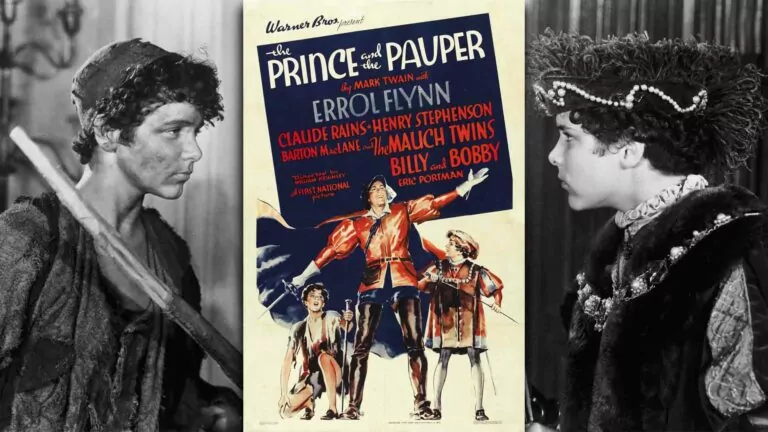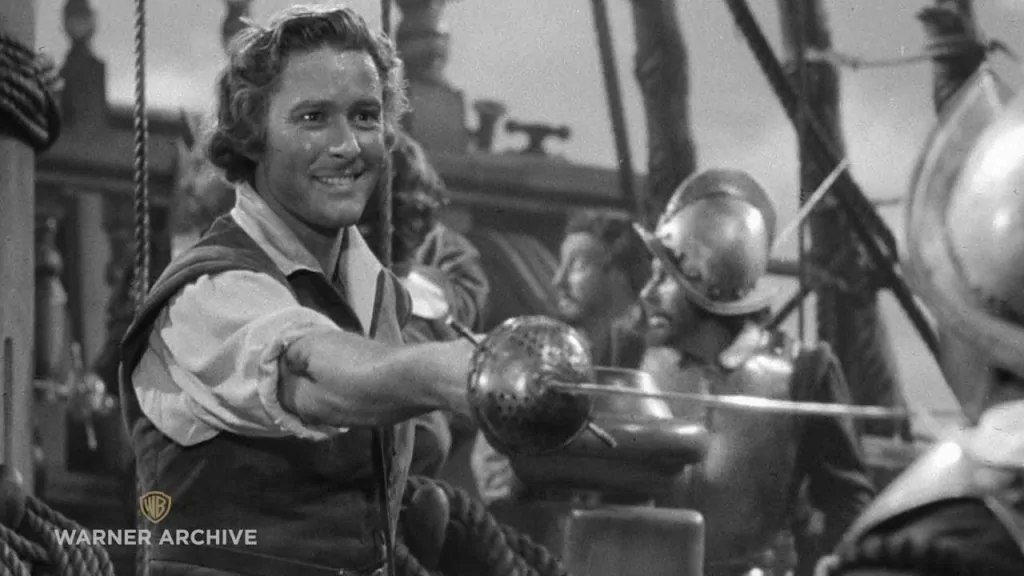Adventure
1937 / 118 minutes
RATING: 8/10
The swashbuckling Errol Flynn stars in one of the earliest, and still one of the best, film adaptations of Mark Twain’s classic tale of switched identity.
Our story begins on a murky evening in the London of 1537, with citizens raising a toast to the birth of Edward Tudor, the royal heir. His father, Henry VIII, warns the little babe that heavy weighs the crown. This same night, in the poorest corner of the London slums, another boy is born, by the name of Tom Canty. His father also has words for him, cursing the boy for being born healthy and strong, because “it’s only the sickly ones that can beg a farthing.”
Ten years later, the pair meet when Tom, fleeing a beating from his father, hides on the palace grounds. The pair are struck by their uncanny resemblance – the two could have been identical twins (and, in fact, identical twins Bobby and Billy Mauch play the roles). As part of their play, they swap clothes. Then, in a shock to both, they are mistaken for each other, and the guards throw the rag-wearing prince right out of the palace, leaving the bewildered Tom trying to get someone, anyone, to believe that he is not the prince.
Where does Errol Flynn come in? He plays Miles Hendon, a poor soldier, who mistakes Edward for addled when the boy insists he is royalty. The boy certainly seems addled. When news of the king’s death spreads among the peasants, he demands that they respect his royal highness – he is after all, their new king! That doesn’t go down well with any of them, and when one gent starts trying to beat the lad, others are more than willing to lend a hand. That’s when Miles comes to the rescue, whisking the boy away. Miles doesn’t believe the boy any more than the mob, but he is willing to humor him… for a time.
With the king’s death, a coronation is quickly scheduled. That means that in just days, unless the two switch back, Tom Canty will be crowned the new king!
Cautions
The cautions here concern violence, but it is all at a level that would bother only the very young. Errol Flynn dispatches one of the bad guys in a swordfight, but the fatal blow is hardly shown.
More notable is the beatings that John Canty gives his son Tom. While the blows aren’t severe – more shoving than any punching – it’s the notion of a father actually beating his son that will disturb some children. Midway through the film, when a priest tries to stop John from beating Tom (though this time it is actually Edward), we see John strike the man in the head with a stick, and the priest falls dead with a spot of blood on his temple. It’s not gory, especially in black and white,
So, this is no “Disneyfied” retelling, but the darker aspects are still greatly muted. (Speaking of, there is an animated 1990 Disney version with Mickey Mouse playing the two title roles. There are a few language concerns – a couple uses of “gosh,” at least one use of “heck,” and “what the devil? – but what turned me off was Donald “comically” praying at a tense moment.)
Conclusion
This will be a good leap off point for discussions about the backstabbing, corrupting nature of politics and why there is a need for good people to enter into the political realm.
Adults may enjoy references to this history of the time; the story is fictional, but the background is straight history. Adults will understand that the reason King Henry VIII “hates priests,” as Edward shares with Tom, is because Henry booted the Roman Catholic Church out of England when the pope wouldn’t grant him an annulment from his first wife. Edward was his only surviving male heir and the son of his third wife who died in childbirth. And as the film also notes, there were still more queens afterward – Henry went on to have six wives in all.
But the real appeal is the pairing of Flynn and Twain – a great story with a great star.
At two hours long, this may test the patience of the younger Tik-Tok generation. But if your kids are able to sit still at all, and if you have an intermission ice cream break halfway through, and equip everyone with their own popcorn bowl, many a kid, 9 and up, should really enjoy it.












